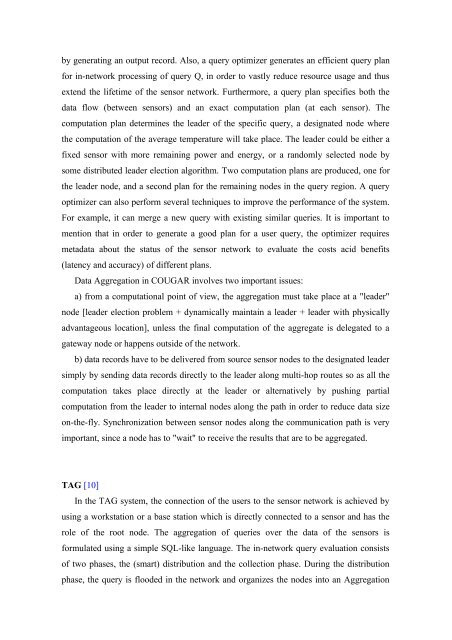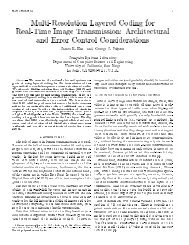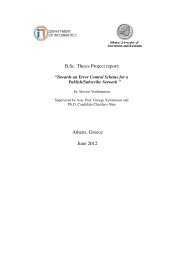In Network Processing and Data Aggregation in
In Network Processing and Data Aggregation in
In Network Processing and Data Aggregation in
Create successful ePaper yourself
Turn your PDF publications into a flip-book with our unique Google optimized e-Paper software.
y generat<strong>in</strong>g an output record. Also, a query optimizer generates an efficient query planfor <strong>in</strong>-network process<strong>in</strong>g of query Q, <strong>in</strong> order to vastly reduce resource usage <strong>and</strong> thusextend the lifetime of the sensor network. Furthermore, a query plan specifies both thedata flow (between sensors) <strong>and</strong> an exact computation plan (at each sensor). Thecomputation plan determ<strong>in</strong>es the leader of the specific query, a designated node wherethe computation of the average temperature will take place. The leader could be either afixed sensor with more rema<strong>in</strong><strong>in</strong>g power <strong>and</strong> energy, or a r<strong>and</strong>omly selected node bysome distributed leader election algorithm. Two computation plans are produced, one forthe leader node, <strong>and</strong> a second plan for the rema<strong>in</strong><strong>in</strong>g nodes <strong>in</strong> the query region. A queryoptimizer can also perform several techniques to improve the performance of the system.For example, it can merge a new query with exist<strong>in</strong>g similar queries. It is important tomention that <strong>in</strong> order to generate a good plan for a user query, the optimizer requiresmetadata about the status of the sensor network to evaluate the costs acid benefits(latency <strong>and</strong> accuracy) of different plans.<strong>Data</strong> <strong>Aggregation</strong> <strong>in</strong> COUGAR <strong>in</strong>volves two important issues:a) from a computational po<strong>in</strong>t of view, the aggregation must take place at a "leader"node [leader election problem + dynamically ma<strong>in</strong>ta<strong>in</strong> a leader + leader with physicallyadvantageous location], unless the f<strong>in</strong>al computation of the aggregate is delegated to agateway node or happens outside of the network.b) data records have to be delivered from source sensor nodes to the designated leadersimply by send<strong>in</strong>g data records directly to the leader along multi-hop routes so as all thecomputation takes place directly at the leader or alternatively by push<strong>in</strong>g partialcomputation from the leader to <strong>in</strong>ternal nodes along the path <strong>in</strong> order to reduce data sizeon-the-fly. Synchronization between sensor nodes along the communication path is veryimportant, s<strong>in</strong>ce a node has to "wait" to receive the results that are to be aggregated.TAG [10]<strong>In</strong> the TAG system, the connection of the users to the sensor network is achieved byus<strong>in</strong>g a workstation or a base station which is directly connected to a sensor <strong>and</strong> has therole of the root node. The aggregation of queries over the data of the sensors isformulated us<strong>in</strong>g a simple SQL-like language. The <strong>in</strong>-network query evaluation consistsof two phases, the (smart) distribution <strong>and</strong> the collection phase. Dur<strong>in</strong>g the distributionphase, the query is flooded <strong>in</strong> the network <strong>and</strong> organizes the nodes <strong>in</strong>to an <strong>Aggregation</strong>








